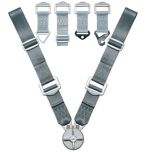Buying a Glider

The decision to buy a new glider depends on so many different factors, whether it be that the club fleet is getting harder to use due to utilisation, your competition desires are changing, new goals emerging, your budget has changed, how much you’re willing to spend versus the amount of time you can actually fly it, the list goes on...
It’s an exciting time in anyone’s life, whether it’s your first purchase or you’re upgrading, there is so much to consider when buying a second-hand glider. Naturally, you want to avoid buying a glider with hidden pitfalls, whether that is because they’re unknown or hidden in hope that the seller might get away with it. The below checklist & thoughts are some important points to consider! I recommend putting all these dot points onto a spreadsheet so that you can write notes & rank each applicable item 1-5 for example.
Glider General
- Glider Type, Registration, Serial number, last inspection date & location.
- It’s a good idea to have a chat with the last inspector of the glider, and get their feedback on the general condition & items that may need attention in the coming years.
- How many hours does it have?
- Logbook maintenance check?
- History of the glider?
- Sloppy maintenance notes or on detail?
Overall condition
- Gelcoat or PU?
- When was it done? Is there any Gelcoat failure? Refinishes are expensive
- Spar bump or surface waviness?
- Paint discolorations or chips?
Wings
- Fore & aft play at the wing tip?
- Control surface play?
- Check all directions
- Are the correct markings presented?
- Do the airbrake caps fit flush?
- Control surface sealing?
Fuselage
- Canopy condition?
- General cockpit condition & cleanliness?
- Rudder cables around the S-bends?
- Harness webbing expiry?
- Instruments?
- What does it have?
- Cracks or moisture within them?
- Oxygen?
- Batteries?
- How many, where & what condition?
- Radio check at a substantial distance?
- Nose &/or winch hook?
- Tyre condition?
- Registration markings presented?
Paperwork
- Weight & Balance, when was it last done?
- It’s extremely important to know what the min & max cockpit weights are. If there is a narrow range, then this will affect resale price into the future. It may also indicate hidden damage, is it recorded in the logbook?
- Winglets fitted?
- Appropriate paperwork to match?
- How many hours does the glider have? When is the life extension due?
Trailer
- Type & overall condition?
- Is there any water leakage?
- Brake & tyre condition?
- Any rust?
- How do the fittings work?
- Tow out gear?
- Do the lights work?
Photographs
- Too many to list, but naturally you’ll want a photo from every 45° angle, of the parachute, cockpit, placards, trailer, points of interest, control surfaces, canopy, tow-out gear, etc
After you have all the information, then it’s time to evaluate it all. Will you need to do any repairs, refinish the glider, change the instruments to your liking, new parachute requirements, etc? Is this the glider for you? If so, what are you willing to pay for it with the condition it’s in.
A fun & rewarding game, I wish you all the best with your new purchase!
Photo by Sean Franke









